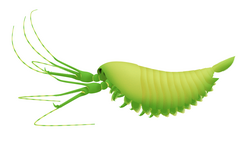- Life reconstruction of Fortiforceps (left) and Sklerolibyon (right)
- Life restoration of Jianfengia
- Closeup of great appendages of Leanchoilia superlata
- Life restoration of Yawunik
- Life restoration of Lomankus
- Life restoration of Oestokerkus
| Megacheira Temporal range: [1] Possible Silurian and Devonian records | |
|---|---|
 | |
| Alalcomenaeus (top left), Fortiforceps (top right), Haikoucaris (middle), Leanchoilia (bottom left) and Yohoia (bottom right). | |
| Scientific classification | |
| Kingdom: | Animalia |
| Phylum: | Arthropoda |
| Class: | † Megacheira Hou and Bergström, 1997 |
| Groups | |
See text | |
Megacheira ("great hands", also historically great appendage arthropods) is an extinct class of predatory arthropods defined by their possession of spined "great appendages". [2] Their taxonomic position is controversial, with studies either considering them stem-group euarthropods, or stem-group chelicerates. [3] [4] The homology of the great appendages to the cephalic appendages of other arthropods is also controversial. Uncontested members of the group were present in marine environments worldwide from the lower Cambrian to the upper Ordovician.









